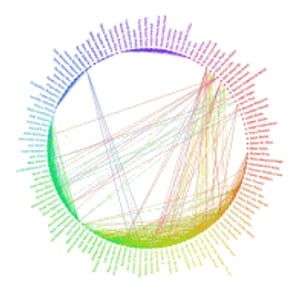
If Facebook is starting to take over your life, maybe your genes are partly to blame.
Researchers from UC San Diego and Harvard University have shown that certain aspects of a person’s social network — how many people consider that person a friend, the likelihood that two of a person’s friends are themselves friends, and how central a person is to their network of friends — have a genetic basis.
Genetics of Social Interactions
The results, published online yesterday in the Proceedings of the National Academy of Sciences, have led to the development of a new model of social interactions and could someday help scientists understand how diseases and traits like obesity, smoking and happiness spread through a population.
James Fowler, Christopher Dawes and Nicholas Christakis studied the social networks of 1,110 sets of twins from 142 separate school friendship networks and compared the similarity in friendship patterns between identical twins, who share 100% of their genes, and same-sex fraternal twins, who share about 50% of their genes.
Twins
The assumption of this type of study is that if genetic variation contributes to variation in a trait, then pairs of identical twins will be more similar to each another with respect to that trait compared to pairs of fraternal twins.
The researchers found that three measures of connectedness are heritable:
- How many times a person is named as a friend
- The likelihood of a person’s friends also being connected to each other directly
- The tendency of a person to be along the shortest path between pairs of their friends
The number of friends people say they have, however, did not appear to have a genetic basis.
Attract and Introduce
The researchers then created a large number of simulations based on existing ideas about how human social networks form. When they observed that none of these simulated networks exhibited the same kind of heritability they saw in their real human networks, they invented a simple model they dubbed “Attract and Introduce.”
A model is simply a mathematical system that attempts to reproduce something seen in the real world based on a limited number of inputs. Every “person” in the Attract and Introduce model of social networks is given just two characteristics — a certain amount of attractiveness, which will determine how many friend nominations he or she will receive, and a certain a propensity for making introductions between new and existing friends, which will determine the number of friends who are friends with each other.
The heritability predictions produced by the Attract and Introduce model fit well with what was seen in the twin study. This suggests that their model may capture important features of how real human social networks form that existing models do not.
“There may be many reasons for genetic variation in the ability to attract or the desire to introduce friends. More friends may mean greater social support in some settings or greater conflict in others. Having denser social connections may improve group solidarity, but it might also insulate a group from beneficial influence or information from individuals outside the group,” the authors write.
Although more research will be needed to explore whether the findings in this study and the model developed apply to all people regardless of age, geography or other factors that could affect the interactions between people, this type of research has important implications. Understanding how people come together and interact could be used to predict or control the spread of communicable disease. The authors also note that their own previous research has shown that obesity, smoking behavior, happiness, and even political behavior spread in social networks.
“A full understanding of these traits may require a better understanding of the genetic basis of social network topology,” they suggest.